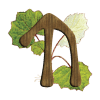
Harvesting
Instructions | Harvesting | Drying | Storing
Parts above ground should be collected when the weather is good and dry, but not hot. Containers should be rigid; preferably baskets. Avoid the roadside and other places which may be contaminated by for example pesticides.
The person, who’s harvesting, shouldn’t have any open wounds on his/her hands and should avoid eating, drinking and smoking while harvesting. Poisonous plants mustn’t be gathered at the same hour as others and should be stored separately. Don’t harvest more than you can dry.

Leaves
Pick them when they’re young, fully grown, fresh and clean. Preferably before the flowering starts
Plant parts
Leaves, flowers and stem mixed. Harvest these when the plants starts to blossom.
Flowers
Pick them at the start of the flowering period because the flowers continue to develop after they’ve been separated from the plant. Handle them with care so they don’t get squashed. Don’t gather them in plastic containers. They will “sweat” and that will ruin the quality.
Fruit
Collect the fruit when it starts to ripen. The fruit also continues to develop after it’s picked. Remove the seeds.
Bark
Harvest the bark in spring, when the sap is rising. First, make to horizontal cuts 20-30cm (8-12″) apart. Then make a vertical cut between the two and loosen the bark with a rust-free, blunt tool.
Wood
Harvest thin trunks or thick branches in the spring or fall.
Roots, leeks and similar
Dig them up carefully after the other parts starts to wither.
